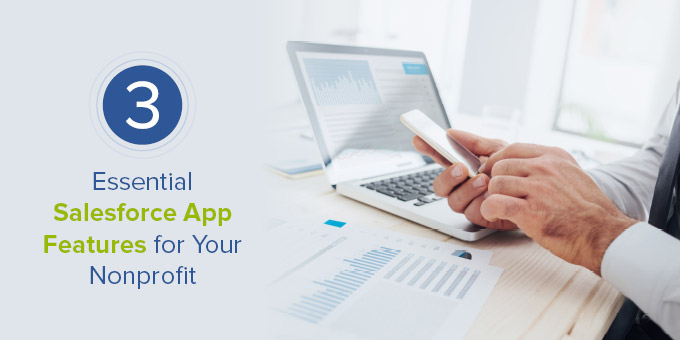 More and more nonprofit organizations are making the move to the Salesforce CRM platform, and for good reason! It’s become an extremely popular solution for a few key reasons:
More and more nonprofit organizations are making the move to the Salesforce CRM platform, and for good reason! It’s become an extremely popular solution for a few key reasons:
- The Salesforce Nonprofit Success Pack offers an affordable way to get started.
- Its cloud-based structure offers a more intuitive and accessible experience.
- It’s extremely flexible and customizable thanks to integrated apps and add-ons.
In terms of utility and ease-of-use, most other nonprofit CRM solutions can’t match a fully built-out configuration of Salesforce. However, it can still take a while for new users (and especially smaller organizations) to get up to speed on the platform.
That’s because you need to customize Salesforce with apps and tools designed specifically for nonprofits before being able to really make the most of it.
Migrating to a brand new CRM platform and then identifying the right tools for your organization can be a big time commitment for smaller teams, so it definitely pays to do your research ahead of time. After all, apps are what make Salesforce such a flexible and effective platform.
Apps and other Salesforce-integrated tools can support any aspect of your operations, from donor stewardship to mobile fundraising. Salesforce apps address a very wide range of purposes and tasks. However, there are a few key characteristics that you should always keep in mind when researching new tools. These are:
- Fully integrated design
- Intuitive data reporting tools
- Part of a larger suite of tools
At Soapbox Engage, we develop apps to help smaller organizations cover all their bases on Salesforce, so we know that making the move to a new CRM can be a major undertaking. Investing in a more modern and flexible solution, though, is always worthwhile.
We’ll walk through each of these characteristics in greater depth, giving you a more thorough understanding of Salesforce in the process. First, though, let’s briefly discuss Salesforce apps for nonprofits more generally.
Overview of Salesforce Apps for Nonprofits
As mentioned above, Salesforce apps can address any aspect of your operations and help streamline any internal process. Some of the most important types of apps that nonprofits use fall into these categories:
- Core fundraising capabilities and online payment processing
- Online event registration and event management
- Internal productivity tools for collaboration, file sharing, etc.
- Digital marketing tools to track and manage your communications
- Accounting tools to help keep funds organized within the CRM
For full overviews of some of our favorite tools in each category, check out our list of the best Salesforce apps for nonprofits.
What are the benefits of working with integrated apps versus standalone tools? The main idea behind using integrated tools is that data will be able to flow freely between each tool and your underlying CRM. For example, an integrated donation app will automatically create new donor profiles in your donor database. This flow of data translates into a few major benefits:
- Streamlined processes and tasks for your team
- Vastly improved data management
- A more comprehensive view of your data
That last benefit is easily the most important. With more data flowing in from your integrated tools, you get a 360-degree view of your nonprofit’s fundraising and marketing performance. Real-time data updates help you to continually refine your strategies.
You probably already have a number of fundraising, marketing, or other internal tools that you rely on. If any of your major tools won’t integrate with Salesforce, you might need to consider looking for new apps to replace them.
Working between separate platforms will waste your team’s time and focus since they’ll need to manually move data from the tools to the central database. This opens up a lot of risk, not only to miss out on new insights but also to simply lose data in the process.
Essential Features to Look for in Salesforce Apps
Once you’re ready to begin researching new Salesforce-integrated tools, there are some key characteristics to look for. Without them, you won’t get nearly as much value from your new toolkit as you would otherwise. Let’s walk through these characteristics now:
Fully Integrated or Native Design
This characteristic is probably the most important. Any new apps or tools you use should be designed to work with the Salesforce Nonprofit Success Pack, the particular configuration that most nonprofits adopt. They need to be either fully integrated or native to the Salesforce platform:
- Integrated apps for Salesforce are designed to work seamlessly with the platform and easily flow data back and forth with the database. However, these tools should still be able to function on their own if needed.
- Native Salesforce apps are designed within the Salesforce system and will work only on Salesforce. They can’t function as standalone tools. They’re often of a fairly large scale and can act as overlays for the entire Salesforce system.
Other apps or add-ons might act more as integration bridges to make sure an existing, separate platform can flow data to and from Salesforce. If you already rely on software that doesn’t integrate directly with Salesforce, they might offer a bridge-style integration that will keep it convenient to use.
For example, let’s say you’ve recently moved to Salesforce and are planning a major capital campaign. If your wealth screening service offers an app to bridge its system with Salesforce, you should be able to easily import and export data between them. Check out the Salesforce DonorSearch app for prospect research for an example of this type of integration.
The main takeaway: Any new tools you adopt after moving to Salesforce should be either fully integrated or native apps. For software that you already rely on, check if they offer a Salesforce app of their own.

Intuitive Data Reporting Tools
Next, any new Salesforce tools you adopt need to include intuitive tools for reporting data back to the central CRM. After all, the whole point of using integrated apps for Salesforce is that they help you make the most of your data and break down barriers between your tools.
Nonprofits of all sizes have seen improvements in their performance after switching to Salesforce largely because better access to your data makes it easier to listen to your donors. Being able to easily analyze in close detail how donors engage with your campaigns and other digital efforts goes a long way to help you refine your strategies over time.
Practically every Salesforce app will by definition include some data reporting capabilities and customization options, but you need to make sure these features are intuitive and truly fit your needs.
For example, any donations app for Salesforce will be able to seamlessly import your transaction data to the database. However, that data might not get properly sorted to the profiles of existing donors, which can result in duplicate records. Or your team might have to manually sort through the incoming donation data.
Problems like these can make a big difference in how much you’re able to learn from all the data in your Salesforce database.
Instead, use an integrated donation processor tool that includes more intuitive features, like automatically sorting transactions to an existing donor profile or creating a new one for first-time donors. Ideally, you’ll be able to set unique tracking URLs to report engagement data to specific campaigns, as well.
The main takeaway: Your Salesforce tools need to report their donation, engagement, or other data to the central CRM in ways that make it easier both for your team to manage it and to learn from it.
Part of a Larger Suite of Tools
This means you should look for tools that are part of a whole suite of nonprofit apps if possible. There are a few reasons for this, including:
- Consistent data reporting. As a suite of tools, each app should report data in a similar way. Using a range of apps from very diverse sources can end up requiring a ton of manual data management to reconcile duplicate entries, for instance.
- More comprehensive data. Using Salesforce apps to manage numerous aspects of your digital operations means that you’ll generate more data every time a donor or user engages with it. For example, using Salesforce event registration apps (learn more here) alongside a donations tool from the same suite will let you quickly see how many of your registrants are also past donors.
- More flexible pricing options. Suites of apps will typically give you more flexible options to pick and choose which tools you’ll need, including tiered packages at different price levels. Being able to configure a package of core tools at once can save your team a lot of time going forward.
Using Salesforce tools that all work well together is a logical choice. The Salesforce ecosystem becomes more valuable for your organization the more you invest in it. The more data you generate, the more you can learn, and the more you can improve your strategies.
When your tools can all draw from and contribute to the same pool of data, you can make more targeted decisions. People who’ve signed your petitions, for instance, are clearly motivated by your mission and related issues and would likely be willing to donate. If you’re hosting an advocacy campaign, check if your current suite of fundraising apps offers petition or action alert tools. Explore the Soapbox Engage guide to Salesforce advocacy apps for more examples.
The main takeaway: Building your toolkit around a suite of integrated apps has some major benefits, including the ability to generate more data than you would from separate apps.
Salesforce can benefit nonprofit organizations of all sizes, but the key to success is in the toolkit of apps that you build to accompany it. By identifying and using the integrated tools that include these core features, you’ll be positioned to succeed with Salesforce. Good luck!
About the Author
 As the founder of a software company serving the public sector, Ryan Ozimek is passionate about empowering organizations to “do good.” With a focus on effective and efficient technology solutions, he’s constantly looking for ways in which the Internet can better serve the greater good, and more specifically the non-profit sector. He leads up the Soapbox Engage team in our pursuit of affordable and accidental techie-friendly online engagement software, is a Salesforce MVP, and leads the NPSP Days around the world. Ryan has a bachelor’s degree in communications from UCLA, and a master’s degree in public policy from UCLA’s School of Public Affairs. He’s also a fan of burritos, so if you have any tips to finding the best taqueria in the world, let him know.
As the founder of a software company serving the public sector, Ryan Ozimek is passionate about empowering organizations to “do good.” With a focus on effective and efficient technology solutions, he’s constantly looking for ways in which the Internet can better serve the greater good, and more specifically the non-profit sector. He leads up the Soapbox Engage team in our pursuit of affordable and accidental techie-friendly online engagement software, is a Salesforce MVP, and leads the NPSP Days around the world. Ryan has a bachelor’s degree in communications from UCLA, and a master’s degree in public policy from UCLA’s School of Public Affairs. He’s also a fan of burritos, so if you have any tips to finding the best taqueria in the world, let him know.






Add Comment